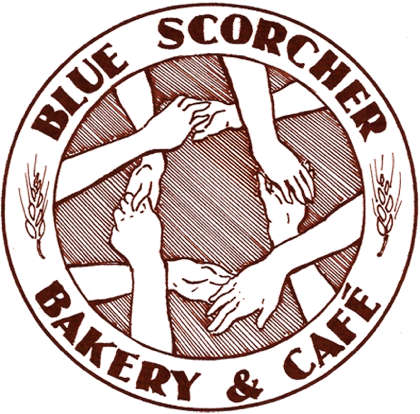Democracy at Work
Sociocracy
Webinar with Joe and Peggy: How does sociocracy work in a worker-owned coop? Joe and Peggy, worker-owners of the Blue Scorcher Bakery, discuss using sociocracy as a governance model. How does sociocracy change group dynamics? Are non-owners part of self-governance?
Sociocracy vests the power to rule in the Socios - the people who regularly interact with one another and have a common aim. Sociocracy is an organizational structure that ensures each member of the Socios has a voice that cannot be ignored in the managing of the organization.
In contrast:
- Democracy vests the power to rule in the Demos - a collection of people who may or may not know each other and have only general aims in common, such as the right running of a country or committee. The majority of the Demos may ignore the minority of the Demos as they make decisions.
- Autocratically structured organizations invest the power to rule in an Auto - a single person, like a CEO. That leader may ignore the rest of the organization as he or she makes decisions on behalf of the whole.
In both aforementioned structures, the voice of the people - the Socios - may not be heard or represented. However, even these structures may develop into a sociocratic organization by simply overlaying a positive feedback circle structure over its existing autocratic structure. An organization with a circle structure - with effective variety, defined aims, dissemination of information, collection of feedback, and inclusive leadership - quickly blossoms in productivity, engagement, and innovation as semi-autonomous and authoritative circles coordinate harmoniously.
The basis of decision making in a circle structure is consent. The principle of consent has some subtle, but important, differences from the use of unanimity. While unanimity seeks agreement by all, consent seeks permission to take action where there is no reasoned objection. Making decisions based on consent allows for informed risk-taking, information based reasoning, adaptability, whole ownership, and accountability at every level of the organization.
Adapted from Sociocracy for All.
Our Circle Structure
Our cooperative is organized in a hierarchy from Worker Member Circle ('Owner Circle') to Board of Directors ('Board') to General Circle to Department Circle to Section Circle:
- Our Owner Circle membership is comprised of approved worker-owners, some who have been with the cooperative for over 10 years. The Owner Circle is responsible for reviewing new ownership applications, authorizing new classes of membership, providing input on the operating budget, overseeing the expulsion or resignation of members, changing the number necessary for quorum at membership meetings, amending the bylaws, and sending members to the Board to be elected into positions.
- Our Board membership is comprised of at least one elected representative from the General Circle, at least three representatives from the Owner Circle, at least one industry expert from an external organization, and at least one General Manager who is elected by the Board from candidates put forth by the Owner Circle. The Board is responsible for managing the long-term well-being of the cooperative, including sustaining our values, electing the Board roles of President, Financial Officer, Secretary, and General Manager.
- Our General Circle membership is comprised of the elected General Manager, elected Lead from each Department Circle, and at least one elected Representative from each Department Circle; the General Circle also elects a non-owner Representative who represents the General Circle at Board meetings. The General Circle is responsible for managing the day-to-day operations of the cooperative, including developing and approving policy, delegating some authority to the Department Circles to function semi-autonomously to achieve their objectives, assigning tasks to members to execute policy, and deciding to consolidate, create, or dissolve Department Circles, within the limits set by the Board.
- Our Department Circles are comprised of operational workers in their respective departments: Barista, Bread, Cafe, Chocolate, Maintenance, and Pastry. Each Department Circle has feedback links to the management General Circle through an operational Lead (who is elected at the General Circle ) and an operational circle Representative (who is elected by their Department Circle). The Department Circles are each responsible for developing and approving policy, assigning tasks to members to execute policy, and deciding to consolidate, create, or dissolve Section Circles, within limits set by the General Circle.
- At this time, we do not functionally utilize Section Circles; however, a Department Circle may choose to create a Section Circle comprised of a Lead and its own members.


